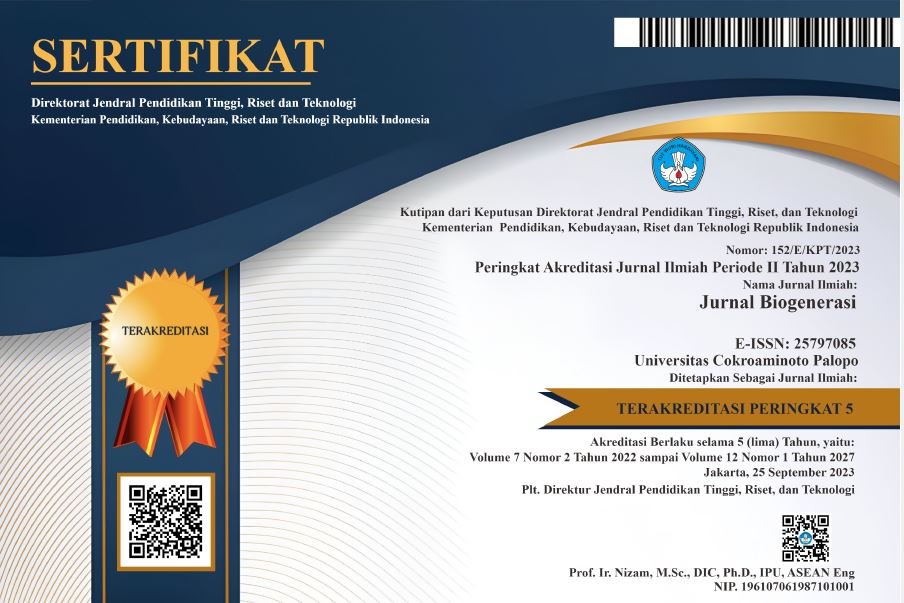K Kandungan Vitamin C dari BuahTomat Pada Tingkat Kematangan yang Berbeda
DOI:
https://doi.org/10.30605/biogenerasi.v6i2.543Keywords:
Vitamin C; Tingkat Kematangan, TomatAbstract
Buah tomat memiliki kandungan vitamin C yang cukup tinggi, namun kandungannya bergantung kepada waktu perkembangannya. Dengan demikian tingkat kematangan dari buah menjadi salah satu faktor yang mempengaruhi kandungan vitamin C. Bagaimana tingkat perkembangan mempengaruhi kandungan vitamin C belum ada studi-studi yang dilakukan. Oleh karena itu, studi ini bertujuan untuk menentukan kandungan vitamin C dari buah tomat (Lycopersicon esculentum) pada tingkat kematangan yang berbeda yakni buah mentah, mengkal dan matang. Studi dilakukan dengan melakukan pengukuran nilai serapan dari masing-masing sampel ekstrak buah tomat dengan menggunakan spektrofotometer UV-Vis. Hasil studi menunjukkan bahwa kandungan vitamin C dari buah tomat mentah sebesar 217,31 mg, buah tomat mengkal sebanyak 257,31 mg dan buah tomat matang sebanyak 238,17 mg dalam 100 g buah tomat. Dengan demikian dapat disimpulkan bahwa buah tomat mengkal memiliki kandungan vitamin C tertinggi dibandingkan dengan buah tomat mentah dan matang.
Downloads
References
Arief. (2011). Media Pendidikan (Pengertian, Pengembangan dan Manfaatnya). Jakarta: Rajawali Pers.
Arikunto, S. (2012). Prosedur Penilaian Suatu Pendekatan Praktek. Edisi revisi V. Jakarta: PT. Rineka Cipta.
Canene-Adams K., Clinton, S.K., King, J.L., Lindshield, B.L., Wharton C., Jeffery, E. & Erdman, J.W.Jr. (2004). The growth of the Dunning R-3327-H transplantable prostate adenocarcinoma in rats fed diets containing tomato, broccoli, lycopene, or receiving finasteride treatment. FASEB J. 18: A886 (591.4). USA: Los Alamos National Laboratory.
Depkes RI. (2000). Materia Medika Indonesia. Jilid V. Jakarta: Direktorat Jenderal Pengawasan Obat Dan Makanan. Halaman 194-197, 513-520, 536, 539-540,549-552.
Dewanti, T. (2010). Aneka Produk Olahan Tomat Dan Cabe. Malang: Universitas Brawijaya.
Febrizky, S., Mario, A., Aziz, T. (2014). Pengaruh jenis pelarut terhadap persen yieldalkaloid dari daun salam india (muraya keonigii). Jurnal Teknik Kimia, 2(20), 1-6.
Jung, H.C. and Wells, W.W. (1997). Spontaneous Conversion of L-Dehydroascorbic Acid to L-Ascorbic Acid and L-Erythroascorbic Acid. Biochemistry & Biophysic Article. 355:9-14.
Seminar, K., Buono, Alim, M.(2006). Uji Dan Aplikasi Komputasi Paralel Pada Jaringan Syaraf Probabilistik (PNN) Untuk Proses Klasifikasi Mutu Tomat. Jurnal Teknologi. Edisi No. 1 34-45.
Shalunkhe dan Desai. (1984). Posthharvest biotechnology of vegetables. Florida: Crc Press Inc.
Tonucci, L.; M.J. Holden; G.R. Beecher; F. Khacik; C.S. Davis; G. Mulokozi. (1995). ”carotenoid content of thermally processed tomato based food product”, J. Agric, Food Chines Chem., (43):579-586.
Turgiyono. (2002). Budidaya Tanaman Tomat. Yogyakarta: Kanisius.
Wardani, L. (2012). Validasi metode analisis dan penentuan kadar vitamin c pada minuman buah kemasan dengan spektrofotometri uv - vis. Jakarta: Universitas Indonesia.
Downloads
Published
How to Cite
Issue
Section
License
In submitting the manuscript to the journal, the authors certify that:
- They are authorized by their co-authors to enter into these arrangements.
- The work described has not been formally published before, except in the form of an abstract or as part of a published lecture, review, thesis, or overlay journal.
- That it is not under consideration for publication elsewhere,
- That its publication has been approved by all the author(s) and by the responsible authorities – tacitly or explicitly – of the institutes where the work has been carried out.
- They secure the right to reproduce any material that has already been published or copyrighted elsewhere.
- They agree to the following license and copyright agreement.
License and Copyright Agreement
Authors who publish with this journal agree to the following terms:
- Authors retain copyright and grant the journal right of first publication with the work simultaneously licensed under Creative Commons Attribution License (CC BY 4.0) that allows others to share the work with an acknowledgment of the work's authorship and initial publication in this journal.
- Authors are able to enter into separate, additional contractual arrangements for the non-exclusive distribution of the journal's published version of the work (e.g., post it to an institutional repository or publish it in a book), with an acknowledgment of its initial publication in this journal.
- Authors are permitted and encouraged to post their work online (e.g., in institutional repositories or on their website) prior to and during the submission process, as it can lead to productive exchanges, as well as earlier and greater citation of published work.


.png)

